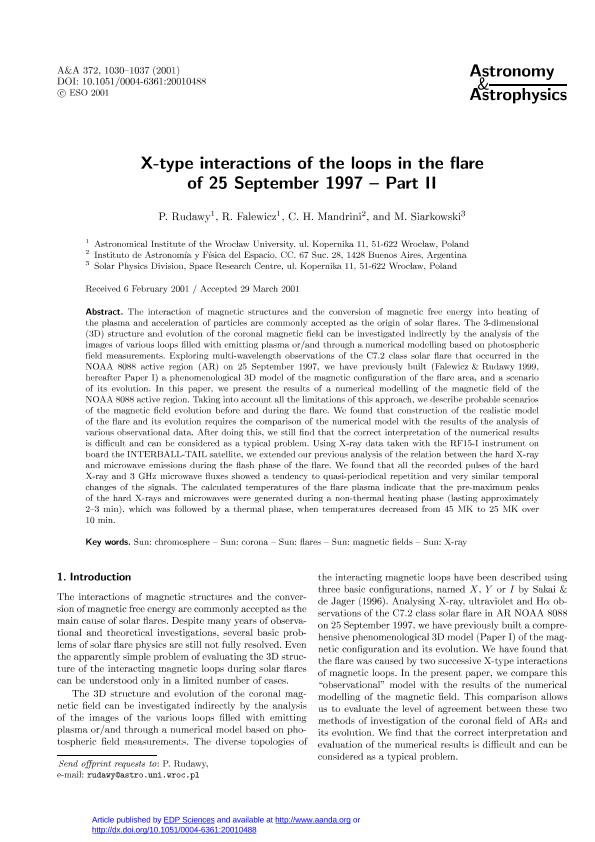Mostrar el registro sencillo del ítem
dc.contributor.author
Rudawy, P.
dc.contributor.author
Falewicz, R.
dc.contributor.author
Mandrini, Cristina Hemilse

dc.contributor.author
Siarkowski, M.
dc.date.available
2017-08-15T16:50:20Z
dc.date.issued
2001-06
dc.identifier.citation
Rudawy, P.; Falewicz, R.; Mandrini, Cristina Hemilse; Siarkowski, M.; X-type interactions of the loops in the flare of 25 September 1997 - Part II; EDP Sciences; Astronomy and Astrophysics; 372; 3; 6-2001; 1030-1037
dc.identifier.issn
0004-6361
dc.identifier.uri
http://hdl.handle.net/11336/22464
dc.description.abstract
The interaction of magnetic structures and the conversion of magnetic free energy into heating of the plasma and acceleration of particles are commonly accepted as the origin of solar flares. The 3-dimensional (3D) structure and evolution of the coronal magnetic field can be investigated indirectly by the analysis of the images of various loops filled with emitting plasma or/and through a numerical modelling based on photospheric field measurements. Exploring multi-wavelength observations of the C7.2 class solar flare that occurred in the NOAA 8088 active region (AR) on 25 September 1997, we have previously built (\cite{Fal99}, hereafter Paper I) a phenomenological 3D model of the magnetic configuration of the flare area, and a scenario of its evolution. In this paper, we present the results of a numerical modelling of the magnetic field of the NOAA 8088 active region. Taking into account all the limitations of this approach, we describe probable scenarios of the magnetic field evolution before and during the flare. We found that construction of the realistic model of the flare and its evolution requires the comparison of the numerical model with the results of the analysis of various observational data. After doing this, we still find that the correct interpretation of the numerical results is difficult and can be considered as a typical problem. Using X-ray data taken with the RF15-I instrument on board the INTERBALL-TAIL satellite, we extended our previous analysis of the relation between the hard X-ray and microwave emissions during the flash phase of the flare. We found that all the recorded pulses of the hard X-ray and 3 GHz microwave fluxes showed a tendency to quasi-periodical repetition and very similar temporal changes of the signals. The calculated temperatures of the flare plasma indicate that the pre-maximum peaks of the hard X-rays and microwaves were generated during a non-thermal heating phase (lasting approximately 2-3 min), which was followed by a thermal phase, when temperatures decreased from 45 MK to 25 MK over 10 min.
dc.format
application/pdf
dc.language.iso
eng
dc.publisher
EDP Sciences

dc.rights
info:eu-repo/semantics/openAccess
dc.rights.uri
https://creativecommons.org/licenses/by-nc-sa/2.5/ar/
dc.subject
Solar Chromosphere
dc.subject
Solar Corona
dc.subject
Solar Magnetic Fields
dc.subject
Solar Flares
dc.subject.classification
Astronomía

dc.subject.classification
Ciencias Físicas

dc.subject.classification
CIENCIAS NATURALES Y EXACTAS

dc.title
X-type interactions of the loops in the flare of 25 September 1997 - Part II
dc.type
info:eu-repo/semantics/article
dc.type
info:ar-repo/semantics/artículo
dc.type
info:eu-repo/semantics/publishedVersion
dc.date.updated
2017-08-14T17:44:01Z
dc.journal.volume
372
dc.journal.number
3
dc.journal.pagination
1030-1037
dc.journal.pais
Francia

dc.journal.ciudad
Paris
dc.description.fil
Fil: Rudawy, P.. Astronomical Institute of the Wroc law University; Polonia
dc.description.fil
Fil: Falewicz, R.. Astronomical Institute of the Wroc law University; Polonia
dc.description.fil
Fil: Mandrini, Cristina Hemilse. Consejo Nacional de Investigaciónes Científicas y Técnicas. Oficina de Coordinación Administrativa Ciudad Universitaria. Instituto de Astronomía y Física del Espacio. - Universidad de Buenos Aires. Facultad de Ciencias Exactas y Naturales. Instituto de Astronomía y Física del Espacio; Argentina
dc.description.fil
Fil: Siarkowski, M.. Space Research Centre; Polonia
dc.journal.title
Astronomy and Astrophysics

dc.relation.alternativeid
info:eu-repo/semantics/altIdentifier/doi/http://dx.doi.org/10.1051/0004-6361:20010488
dc.relation.alternativeid
info:eu-repo/semantics/altIdentifier/url/https://www.aanda.org/articles/aa/abs/2001/24/aa1115/aa1115.html
Archivos asociados
